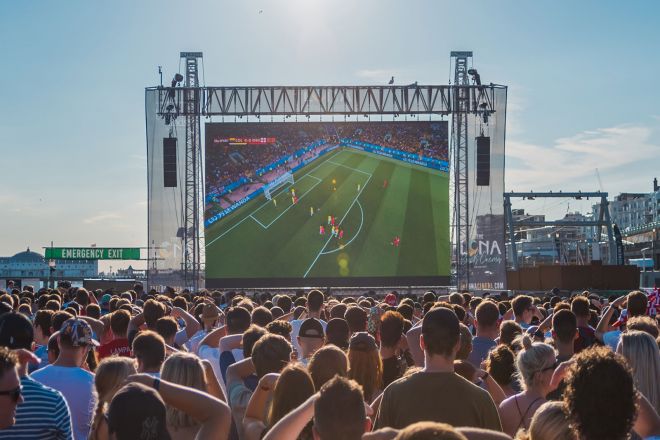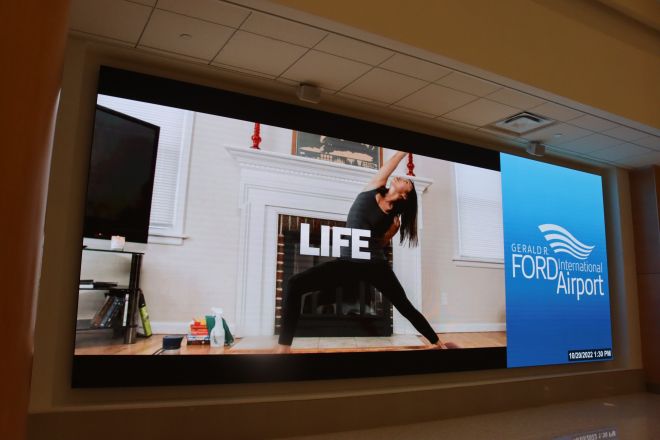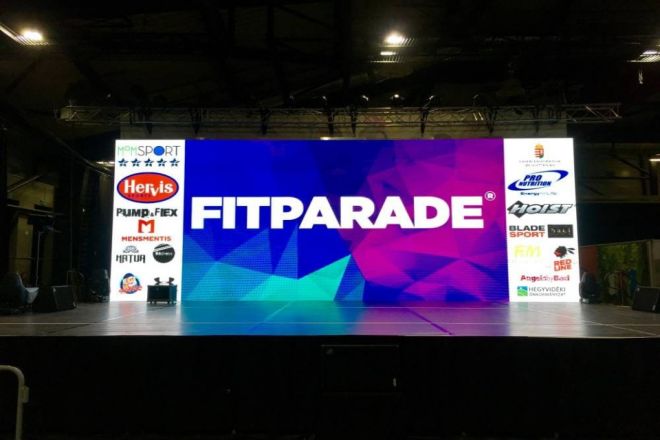Introduction

From the initial budding to today’s maturity and diversity, it has witnessed the rapid progress of science and technology and the continuous evolution of market demand.
In this process, with its unique advantages, the LED display screen has gradually occupied an important position in advertising, sports, entertainment, and other fields and has become an indispensable part of modern society.
This article will provide details of the development history of the LED display industry. Let’s take a look.
1. What is the earliest application and use of LED display?
The earliest appearance of LED displays can be traced back to the late 1960s and early 1970s. During this period, with the birth and development of LED (light-emitting diode) technology, people began to try to apply it to the display field.
The original LED display can only display a single color, such as red or green, which is mainly used for simple numerical and text display.
The earliest application and use of LED display is mainly concentrated on the monochrome LED display, which is mainly used for basic digital and text display.
These displays were originally mainly used for public information releases, such as time displays, weather forecasts, advertising slogans, etc. They are usually installed in public places, such as shopping malls, railway stations, airports, etc., in order to convey information to the public.
With the continuous progress of technology, the scope of use and application of LED display screens has gradually expanded. They began to be used for more complex images and video displays, such as live events in stadiums, outdoor billboards, stage backgrounds, etc.
In addition, due to its high brightness, weather resistance, and energy saving, LED display screens have also been widely used in traffic indications, safety warnings, information releases, and other fields.
2. How did LED display technology develop from a monochrome display to a full-color display?

The development of LED display technology from monochrome to full color is a process full of challenges and innovation, which has witnessed the continuous progress of science and technology and the increasing maturity of the market.
In the early days of LED display technology, monochromatic displays were the mainstay. These displays usually only display one color, such as red or green, and are mainly used for numerical, text, and simple icon displays. They are widely used in public clocks, bulletin boards, etc., to provide basic information services for people.
However, with the increasing demand for information displays, monochrome display screens can no longer meet the market demand. As a result, scientists began to explore how to display multiple colors on the display screen.
The multi-color LED display came into being. It uses a combination of LED beads of different colors to realize the display of red, green, blue, and other colors. The emergence of this technology has made the LED display more widely used in advertising, publicity, and other fields.
However, multi-color displays still cannot meet people’s pursuit of color richness and authenticity. As a result, the research and development of full-color LED display technology has become the focus of the industry.
The full-color LED display uses LED beads in three basic colors, red, green, and blue (RGB), to control the brightness of each LED color accurately and achieve a real color display. This technology enables the LED display to present more delicate and realistic images and video effects, which greatly improves the user’s visual experience.
In the research and development of full-color LED display technology, scientists also face many technical challenges. For example, I learned how to ensure the consistency of the brightness, chroma, and other parameters of the three color LED beads, as well as how to optimize the drive circuit and control algorithm to achieve more accurate color control.
Through continuous experiments and improvements, these technical problems have been gradually overcome, and the performance and stability of the full-color LED display screen have been significantly improved.
With the maturity of full-color LED display technology and the continuous expansion of application fields, scientists continue to optimize and upgrade it. By improving the production process and improving the performance of materials, they have further improved the key indicators such as the resolution, brightness, and contrast of the display screen.
At the same time, they have also developed new products such as flexible LED displays and foldable LED displays, making LED displays more flexible in shape and size and can meet the application needs of more complex scenarios.
3. How does the cost and affordability of the LED display change over time?
The cost and affordability of LED display displays show a dynamic relationship over time, which is affected by a variety of factors such as technological progress, market demand, raw material price, and supply chain status. The following is a detailed analysis of these changes and their influencing factors:
First of all, from the perspective of technological progress, with the continuous innovation of LED manufacturing technology, the production efficiency has been significantly improved, and the unit cost has been reduced accordingly.
This has gradually reduced the cost of LED displays, and the market affordability has also increased. At the same time, with the upgrading of display technology, such as the application of high refresh rate, high resolution, high contrast, and other technologies, although the initial investment cost has increased, the user experience and display effect have been improved, making the product more competitive.
Secondly, market demand also has a significant impact on the cost and affordability of LED displays. With the rapid development of advertising, sports, entertainment, and other industries, the demand for LED display screens is increasing.
This promotes the large-scale development of the industry and reduces the unit cost. At the same time, the intensification of market competition also makes manufacturers more flexible in pricing to meet the needs of different customer groups.
In addition, the price of raw materials and supply chain are also important factors affecting the cost of LED displays. The main raw materials of LED displays include LED chips, drive circuits, shells, etc. The price fluctuations of these materials directly affect the cost of the product.
At the same time, the stability and efficiency of the supply chain also have an important impact on costs. If the supply chain breaks or transportation costs rise, it may lead to an increase in product costs.
In terms of pricing, in addition to the cost factors mentioned above, it is also affected by factors such as market competition, product positioning, value perception, seasonal factors, and target markets. Specifically, the degree of market competition determines the flexibility and space of manufacturers in pricing.
Product positioning and value perception determine the premium ability of products; seasonal factors may lead to an imbalance between the supply and demand of products in a specific period, thus affecting pricing; while the consumption capacity of the target market and consumption habits determine the product. Market demand and pricing strategy.
4. What are the main trends and technological advances in every decade of the LED display industry?

The main trends and technological progress in every decade in the history of the LED display industry are closely related, and they have jointly promoted the rapid development of the industry. The following is an overview of the main trends and technological advances in each decade:
1). 1980s to 1990s: initial formation and monochrome display
Main trend:
The LED display industry was initially formed, mainly focusing on the production and application of monochrome display screens. Due to the limitation of LED material devices, the application field is relatively limited, mainly for specific industries or professional occasions.
Technological progress:
Preliminary results have been made in the research and development of LED materials, and the stability and brightness of monochrome LEDs have been improved.
In addition, simple control circuits and drive modes have been applied to the display screen, which provides support for its basic functions.
2). 1990s to 2000s: Breakthrough and wide application of full-color technology
Main trend:
Major breakthroughs have been made in full-color LED display technology, and the market application has expanded rapidly. With the progress of technology and the reduction of costs, full-color display screens have begun to enter a wider range of fields such as stadiums and billboards.
Technological progress:
The successful development of blue LED chips makes full-color displays possible. The emergence of video control technology has greatly improved the dynamic display effect and grayscale level of the display screen. In addition, the optimization of the drive circuit and control system also improves the stability and reliability of the display.
3). The 2000s to 2010s: the development of high-definition, large-size, and energy-saving technologies
Main trends:
High-definition and large size have become the mainstream demand of the LED display market. At the same time, with the improvement of environmental awareness, energy-saving technology has also become an important direction for the development of the industry.
Technological progress:
The introduction of high-definition display technology has greatly improved the resolution and clarity of LED displays.
The maturity of large-size splicing technology meets the needs of large-scale events and commercial displays. In addition, the research and development and application of energy-saving technology reduce the energy consumption and operating costs of the display screen.
4). From the 2010s to the present: intelligent, flexible, and innovative applications
Main trend:
The LED display industry is developing in the direction of intelligence and flexibility, while constantly exploring new application fields.
Intelligent technology makes the display screen interactive in real-time and information transmission more convenient; flexible technology makes the display screen more diverse and adaptable to more complex environments.
Technological progress:
The research and development of intelligent control systems enables the LED display to realize remote control, intelligent adjustment, and other functions. Breakthroughs in flexible LED materials and substrate technology make it possible for the commercial application of flexible display screens.
In addition, with the integration of the Internet of Things, big data, and other technologies, the application of LED display screens in smart cities, intelligent transportation, and other fields has also been expanded.
5. All types of LED displays so far

There are many kinds of LED displays, covering multiple application fields and different technical characteristics. The following are the main types of LED displays so far:
1). Intelligent and functional LED display:
- Intelligent LED display: No need to connect the computer host, built-in CPU, can save multiple pictures, and operate independently. In addition, some screens are also equipped with clock chips, which can actively display the date and time. There are generally fewer display methods, including pull-up, pop-up, up-roll, and down-roll.
- Functional LED display: It is usually necessary to connect to the computer host for work.
2). Indoor, outdoor, and semi-outdoor LED display:
- Indoor LED display screen: The area is generally small, the point density is high, and it usually does not have the sealing and waterproof ability, which is suitable for viewing distance.
- Outdoor and semi-outdoor LED display: Designed for outdoor environments, with higher waterproof, dustproof, and weather resistance, suitable for long-distance viewing.
3). Monochrome, two-color and three-color LED display:
- Monochrome LED display: Only one color of luminous material, usually red.
- Dual-color LED display: It is composed of light-emitting materials in two colors (such as red and yellow-green)
Three-color LED display: it is divided into two types: full color and true color. The full colors are composed of red, green, and blue, while the true colors are composed of red, pure green, and blue.
4). Apply a specific type of LED display:
LED rental display: designed for the rental market, convenient for transportation and rapid installation, and often used for temporary events or exhibitions.
LED small spacing screen: small pixel spacing, suitable for close viewing and high-resolution display, commonly used in high-end commercial places.
LED transparent screen: It has high transparency and can be integrated with the background environment. It is often used in shopping malls, windows, and other places that need to keep a clear view.
LED creative display: with a unique shape and design for creative display and advertising attraction.
In addition, there are some special types of LED displays, such as flexible LED displays, foldable LED displays, etc., which have higher flexibility and innovation, bringing more possibilities to the application field of LED displays.
With the continuous progress of science and technology and the continuous development of the market, the types and technical characteristics of LED displays are also constantly evolving and upgrading.
Conclusion
Let’s look forward to the future development of the LED industry, which can continue to write a more brilliant chapter and create a better visual world for mankind.
Finally, if you want to know more about the LED display, please get in touch with us.
